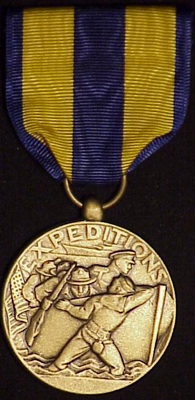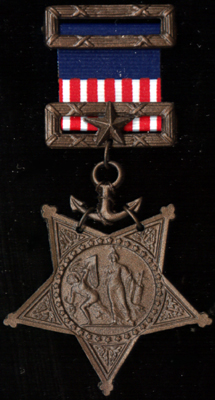USN Egyptian Expedition (1882)

British and US Marines on the Streets of Alexandria 1882


USN and USMC Expeditionary Medals

British and US Marines on the Streets of Alexandria 1882
The 1882 USN Egyptian Expedition was in response to the British and French bombardment of Alexandria, Egypt
during the Anglo-Egyptian War. During the war, British and French warships intervened in a dispute between
the ruling Khedive and a rebellious Army Colonel Ahmad Urabi.
Three US Navy warships, the sloop USS Lancaster, the gunboat USS Nipsic and the corvette USS Quinnebaug under overall command of Rear Admiral James W. Nicholson, were dispatched from the European Fleet to observe the conflict and to intervene on shore, if required to protect US citizens and their property.
The British fleet of 16 ships (nine battleships, five gunboats, one torpedo boat and one steamer) under the command of Admiral Beauchamp Seymour, unleashed a bombardment of the city on July 11, 1882, which created significant damage. The French ironclad corvette, La Galissonniere, was also present in the harbor shortly before the start of the British bombardment. When the engagement began, the British started shelling the various forts under the command of Colonel Urabi. Although the Egyptians admirably defended the city, their fortifications were eventually reduced and silenced over two days of shelling. During the height of the attack, the Americans opened their ships up to all refugees from the city who needed shelter or medical treatment.
On July 14, the British and French attack had ended and Alexandria was in a state of anarchy. The US decided to dispatch a marine and blue jacket landing force to assist in fire fighting and to guard the US Consulate. Captain Henry C. Cochrane was placed in command of 70 Marines and 57 sailors and ordered to occupy the Consulate patrol the city and assist in fire suppression.
The US landing party was the first contingent of foreign troops to enter the city. They were subsequently joined by a “policing” force 4,000 Britons. By July 20, conditions in the city had largely improved so the majority of the Marines and sailors were withdrawn except for a small force from USS Quinnebaug under Lieutenant Frank L. Denny, which remained until July 24.
For the British, the engagement would extend through the Battle of Tel-el-Kebir. The “policing” force would be joined by two armies: (1) 24,000 troops from Britain and (2) and additional 7,000 from India both under the overall command of Lt. General Gamet Wolseley. An additional 40 British warships were dispatched to protect the northern and southern ends of the vital Suez Canal. The battle for Tel-el-Kebir was intense, but short lived and the British overwhelmed the Egyptian forces.
Colonel Urabi was eventually taken prisoner by the British and Khedive Tawfiq was restored to power. Although Egypt would continue as an independent nation, it was in effect a colony of Britain. The heavily damaged City of Alexandria would be rebuilt with British financial support.
US Medals
Established in 1936 and 1919 as a service ribbon and 1921 as a medal, respectively, the USN and USMC Expeditionary Medals were awarded to the officers. crews and Marines embarked on the three US ships for service between June 10, 1882 and August 29, 1882 at Alexandria, Egypt. The award was obviously backdated to include the 1882 Expedition in the list of those eligible for award of the respective medals.
US Navy Expeditionary Medal
In the center of the bronze obverse, a quarter inches in diameter, is a sailor shown beaching a boat containing three men in uniform, one of whom is carrying a rifle. At the rear of the boat there is an American flag. In the upper quarter of the medal, and following the contour of its rim, is the word EXPEDITIONS.
The sailor beaching the boat symbolizes the Navy's role in such expeditions and illustrates the "opposed landing" on a foreign shore. The people in the boat are an officer and two Marines preparing to land. The United States flag represents the authority under which these expeditions are conducted and the ideals of the United States carried to foreign shores during these expeditions.
In the center of the reverse is an eagle shown alight upon an anchor; the eagle is facing to the left, and the flukes of the anchor are to the right side of the medallion. The eagle is grasping sprigs of laurel, which extend beyond the anchor in both directions. Above the eagle are the words UNITED STATES NAVY. Above the laurel on the left is the word FOR, and over the laurel on the right, SERVICE.
Three US Navy warships, the sloop USS Lancaster, the gunboat USS Nipsic and the corvette USS Quinnebaug under overall command of Rear Admiral James W. Nicholson, were dispatched from the European Fleet to observe the conflict and to intervene on shore, if required to protect US citizens and their property.
The British fleet of 16 ships (nine battleships, five gunboats, one torpedo boat and one steamer) under the command of Admiral Beauchamp Seymour, unleashed a bombardment of the city on July 11, 1882, which created significant damage. The French ironclad corvette, La Galissonniere, was also present in the harbor shortly before the start of the British bombardment. When the engagement began, the British started shelling the various forts under the command of Colonel Urabi. Although the Egyptians admirably defended the city, their fortifications were eventually reduced and silenced over two days of shelling. During the height of the attack, the Americans opened their ships up to all refugees from the city who needed shelter or medical treatment.
On July 14, the British and French attack had ended and Alexandria was in a state of anarchy. The US decided to dispatch a marine and blue jacket landing force to assist in fire fighting and to guard the US Consulate. Captain Henry C. Cochrane was placed in command of 70 Marines and 57 sailors and ordered to occupy the Consulate patrol the city and assist in fire suppression.
The US landing party was the first contingent of foreign troops to enter the city. They were subsequently joined by a “policing” force 4,000 Britons. By July 20, conditions in the city had largely improved so the majority of the Marines and sailors were withdrawn except for a small force from USS Quinnebaug under Lieutenant Frank L. Denny, which remained until July 24.
For the British, the engagement would extend through the Battle of Tel-el-Kebir. The “policing” force would be joined by two armies: (1) 24,000 troops from Britain and (2) and additional 7,000 from India both under the overall command of Lt. General Gamet Wolseley. An additional 40 British warships were dispatched to protect the northern and southern ends of the vital Suez Canal. The battle for Tel-el-Kebir was intense, but short lived and the British overwhelmed the Egyptian forces.
Colonel Urabi was eventually taken prisoner by the British and Khedive Tawfiq was restored to power. Although Egypt would continue as an independent nation, it was in effect a colony of Britain. The heavily damaged City of Alexandria would be rebuilt with British financial support.
US Medals
Established in 1936 and 1919 as a service ribbon and 1921 as a medal, respectively, the USN and USMC Expeditionary Medals were awarded to the officers. crews and Marines embarked on the three US ships for service between June 10, 1882 and August 29, 1882 at Alexandria, Egypt. The award was obviously backdated to include the 1882 Expedition in the list of those eligible for award of the respective medals.
US Navy Expeditionary Medal
In the center of the bronze obverse, a quarter inches in diameter, is a sailor shown beaching a boat containing three men in uniform, one of whom is carrying a rifle. At the rear of the boat there is an American flag. In the upper quarter of the medal, and following the contour of its rim, is the word EXPEDITIONS.
The sailor beaching the boat symbolizes the Navy's role in such expeditions and illustrates the "opposed landing" on a foreign shore. The people in the boat are an officer and two Marines preparing to land. The United States flag represents the authority under which these expeditions are conducted and the ideals of the United States carried to foreign shores during these expeditions.
In the center of the reverse is an eagle shown alight upon an anchor; the eagle is facing to the left, and the flukes of the anchor are to the right side of the medallion. The eagle is grasping sprigs of laurel, which extend beyond the anchor in both directions. Above the eagle are the words UNITED STATES NAVY. Above the laurel on the left is the word FOR, and over the laurel on the right, SERVICE.


USN and USMC Expeditionary Medals
USMC Expeditionary Medal
In the center of a bronze obverse, one and a quarter inches in diameter, is a Marine in full pack shown charging with fixed bayonet. There are wave scrolls at the base where they meet at firmament. In the upper half of the medal, following its contour, the word EXPEDITIONS in raised letters. The figure is that of an enlisted Marine "in action, responding to the call of duty." The scroll waves ending at firmament allude to Marine service and signify an opposed landing.
In the center of the reverse, is an eagle shown alight upon an anchor; the eagle is facing to the left, and the flukes of the anchor are to the right side of the medallion. The eagle is grasping sprigs of laurel, which extend beyond the anchor in both directions. Above the eagle are the words UNITED STATES MARINE CORPS. Above the laurel on the left is the word FOR, and over the laurel on the right, SERVICE. The eagle is the American bald eagle and represents the United States; the anchor alludes to naval service. The laurel is symbolic of victory and achievement.
At least two blue jackets received the Medal of Honor for actions at Alexandria, Egypt: (1) Seaman Apprentice August Chandon and (2) Boatswain Mate Hugh Miller.

USN/USMC Medal of Honor Type 2 1882-1904
In the center of a bronze obverse, one and a quarter inches in diameter, is a Marine in full pack shown charging with fixed bayonet. There are wave scrolls at the base where they meet at firmament. In the upper half of the medal, following its contour, the word EXPEDITIONS in raised letters. The figure is that of an enlisted Marine "in action, responding to the call of duty." The scroll waves ending at firmament allude to Marine service and signify an opposed landing.
In the center of the reverse, is an eagle shown alight upon an anchor; the eagle is facing to the left, and the flukes of the anchor are to the right side of the medallion. The eagle is grasping sprigs of laurel, which extend beyond the anchor in both directions. Above the eagle are the words UNITED STATES MARINE CORPS. Above the laurel on the left is the word FOR, and over the laurel on the right, SERVICE. The eagle is the American bald eagle and represents the United States; the anchor alludes to naval service. The laurel is symbolic of victory and achievement.
At least two blue jackets received the Medal of Honor for actions at Alexandria, Egypt: (1) Seaman Apprentice August Chandon and (2) Boatswain Mate Hugh Miller.

USN/USMC Medal of Honor Type 2 1882-1904
Website Maintained by Vaudezilla